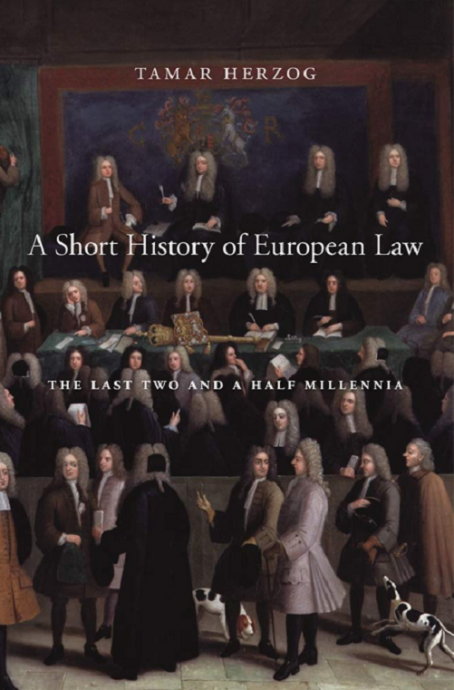European Law and the “Myth of English Exceptionalism”
Like someone with dual citizen allegiance, I am a “legal binational.” My first law degree is Civilian (my JD, and initial practice, are from Québec), but my Yale degree and 33 years’ teaching Torts stateside have definitively branded me a Common Lawyer. I’ve had periods where I thought each system superior to the other. I’ve pondered the difference between legal epistemology and legal substance as I taught Comparative Law. Each year, during annual lectures at George Washington University Law School, I speak to Civilians who marvel at the ability of Americans to function without a written code that purports to answer all questions, and each year I assuage devotees to the common law who treat civil codes as symbols of totalitarian diktats.
Tamar Herzog is a legal historian (with a joint appointment at Harvard in Latin American affairs and in history), and though she has taught in law school, she likely never had exactly my problem. But she has experienced the “comparative dilemma” in her own way, as she explains in the Introduction to her new book, A Short History of European Law.
She reports having encountered an undergraduate student who was looking forward to seeing the Magna Carta when it was on display in Washington, D.C. a few years ago. The undergrad was eager to view the “great charter of liberties.” But this “misreading” of the document evidently aggravated Professor Herzog. She yearned to explain to the student that the Magna Carta was little more than a relic of “a feudal past in which powerful lords sought to protect their jurisdiction and property against an expanding monarchy.” Professor Herzog decided to write this book as a “short, useful introduction to European [where “Europe” includes Britain] legal history that could be used to discuss the evolution of law over time.”
And so she has done. This book is not particularly short (275 densely packed pages). But it is useful for those who require a basic chronological history of the Western legal tradition. The relative lack of footnotes means that this work is intended for students as opposed to researchers. The writing style is serious and descriptive, not breezy or dramatic. It will not be a bedtime read, as sleep might come sooner than anticipated!
Centralized Versus Decentralized Jurisprudence
Professor Herzog details how Roman law expanded, together with Christian hegemony, from England to Bulgaria to the Baltic states. From the 6th through the 10th centuries, Roman law was cross-pollinated by Germanic invaders, to the point where it became very difficult to distinguish the two. This early Roman law was quite primitive, at least on the criminal side: Until the 13th century, the law appealed to divine intervention by forcing criminal defendants to undergo ordeals (placing a limb in boiling water, walking on fire), which would cause no harm if the Lord Almighty indicated that the defendant was in the right. On the Continent, the barbarity of church-imposed ordeals resulted in their replacement by state-appointed inquisitors. But in England, the delegitimization of ordeals encouraged a different response: the rise and increasing power of lay jurors. Thus did the gradual divergence between England and the Continent, between centralized and decentralized authority, originate well before the codification movement.
The author spends some time detailing the ways in which the English system of writs (forms of action) was a politically expedient way for monarchs to procure legitimacy in the face of rival feudal lords. Essentially, the French-speaking conquerors of England offered judicial competition to their subjects. New royal courts had to increase their power (jurisdiction) incrementally, of course, but gradually a reputation for honesty and fairness enabled them to compete successfully with feudal dispute-resolution. Royal courts were (literally) based on forms, not substance, so though the substantive outcome of disputes might be the same, the linguistic approach to their resolution was very different.
Even as late as the 17th century (as Herzog illustrates with a description of Calvin’s Case), basic legal questions could be resolved in England not by a parliamentary act or a royal decree, as on the Continent, but by appealing to the courts and requesting a remedy. This focus on forms, and on decentralized decisionmaking, does not mean that Roman law was foreign to England. To the contrary, as Herzog points out, the common law was developed by a Norman dynasty that used the services and advice of Roman (and canon) law jurists.
Only in the 17th century did a new creation myth (led by Sir Edward Coke and others) arise, according to which the common law was an indigenous Anglo-Saxon system that preceded the Norman Conquest. This paradigm shift (of which William Blackstone was a proponent) saw the common law as created spontaneously by the volk, predating the Conquest. In reality, though, it was the Normans’ procedural tool in their battle with Anglo-Saxon lords. The “myth of English exceptionalism,” writes Herzog, “was the result not so much of what English law actually was but of how it was reimagined.”
Professor Herzog devotes considerable attention to the well-known history of modern (post-Enlightenment) European law, the advancement of reason over faith, and the belief in the possibility of finding and transcribing a complete, logical organization of juridical rules into a coherent system. The title of her book notwithstanding, she devotes a chapter to “North American developments,” in which she relates Coke’s and Blackstone’s view that the upstart American colonies did not practice common law. Her efforts to debunk the “transfer theory” (that the common law was transferred from England to the Americas) are utterly unpersuasive to this author, as they abstract from the juridical culture of the colonies and the legal training of those American jurists who had any.
Ramifications of 1789
More useful is Professor Herzog’s description of the effect of the French Revolution on European ius commune and on the codification movement. Systematization and logical analysis of legal rules had of course proceeded across the Continent, including in England (the prime example being Blackstone’s Commentaries). But the French Revolution brought with it the dual triumph of rational positivism (with its rejection of theistic legitimacy of laws) and nationalism.
The French and German codification movements represent two stylistically different ways of implementing these two notions. Civil codes are “why-stoppers” (that is, immediately upon their adoption, the normative legal theories and the cases that preceded them tend to be abandoned), and in that way are incompatible with the natural law spirit that guided the glossators and post-glossators who systematized prior rulings. Upon independence, nationalistic leaders are attracted to a civil code much as patriots love their flag. But many prominent jurists in non-codified civil law countries (for example, South Africa and Scotland) were horrified at the prospect of codification for this reason.
Positivism and internationalism surely led to the movement for a European civil code, which was vigorously opposed by Great Britain for obvious reasons. Professor Herzog devotes her final chapter to the emerging super-state that is Europe. She describes the virtual coup d’état through which laws adopted in far-off Brussels were held by European Community courts to have supremacy over democratically adopted laws in each member country. “European law became the largest source of new law, with 54% of all new French law originating in Brussels” despite the lack of participation of French voters in EC elections. Of course, Herzog’s book was written before Britain’s Brexit referendum, but it would have been interesting to read her analysis of the influence the triumph of Euro-positivism may have had on the vote.
This book is far from perfect. Its treatment of the United States is, as I have indicated, poor—indeed, Professor Herzog conflates the Louisiana Civil Code (a true civil code that in fact served as the model for the Code civil du Québec) with the code of the state of New York, which is really a common law compilation. But for those interested in understanding the history of European Law and the ways in which its British and Continental variants developed, this is a useful compendium indeed.

